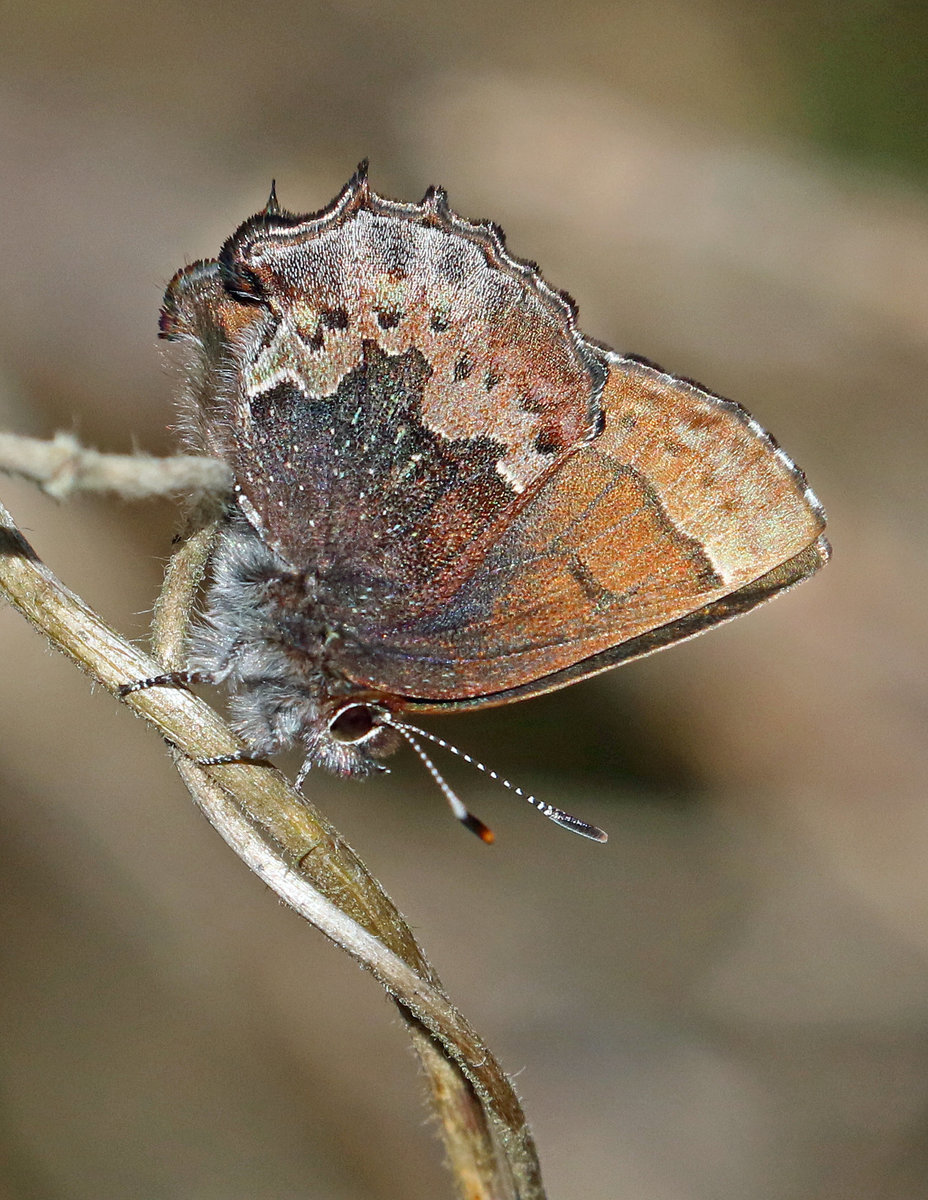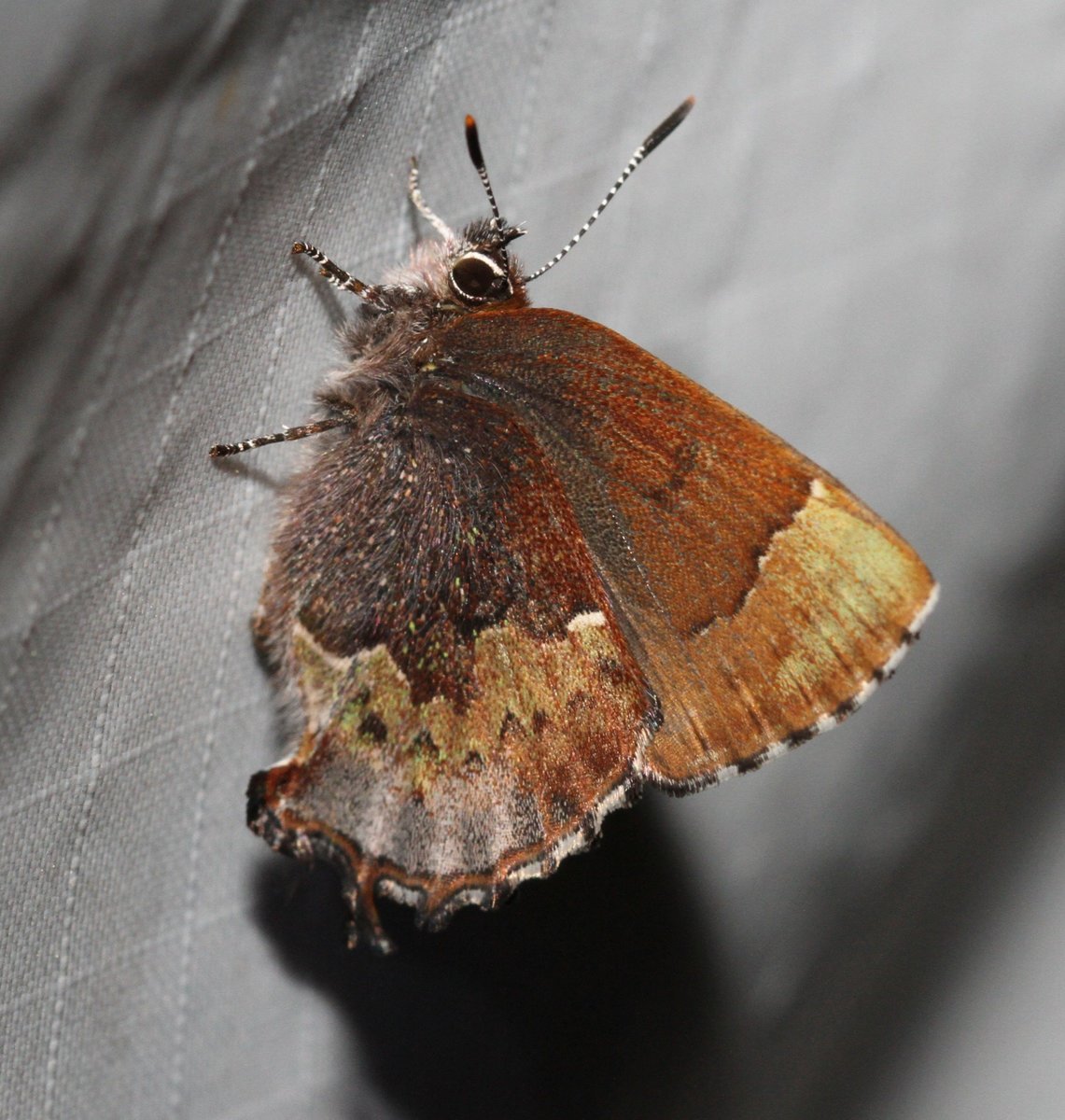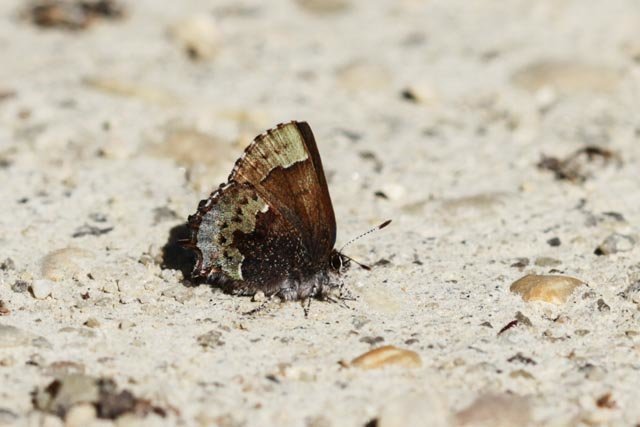Brian Johnson’s recent night-time shot of a Henry’s elfin with green highlights inspired some reading into a spring-season butterfly mystery that has surfaced now and again on our Sightings Log for several years.
The mystery revolves around two questions:
- What plants are the primary hosts for Henry’s elfin on NJ’s Coastal Plain?
- How frequent (and identifiable) are “greenish” Henry’s elfins here?
If either question interests you, the next few weeks are the ideal time to try to help find an answer. Henry’s fly in South Jersey from mid/late March to early/mid-May.
Harry Pavulaan first described a greenish form of Henry’s in The Maryland Entomologist in 1998 and named it as a new subspecies, Incisalia henrici viridissima. He credits Samuel Gifford for discovering the form while doing field work on North Carolina’s Outer Banks from 1974 to 1980. In a report of Gifford’s work on several hairstreaks, Gifford & Opler wrote, “Individuals of the Hatteras population [of Henry’s] had a greenish cast ventrally and might eventually be described as a separate subspecies.”
Pavulaan took up the gauntlet. He examined Gifford’s specimens and dozens of other museum specimens from the East Coast to study the differences. He finally sorted them into five phenotypes: (1) all-brown “nominotypical” Henry’s; (2) viridissima greenish-types; (3) intermediates between all-brown and greenish-types; and (4, 5) two southern subspecies found only from southern South Carolina into Florida.
Then he created a map of their distribution of the eastern range of Henry’s from Florida to Maine. Viridissima and intermediates appear from the Outer Banks northward to northern Virginia, the panhandle of West Virginia, southern Maryland, the Delmarva peninsula, and Cape May County, NJ.
To see that map and to learn many other details, including Pavulaan’s meticulous description of the field marks of greenish Henry’s and his careful discussion of host plants, you can go to the full article linked at the end of this post.
In the meantime, here’s a quick summary of the key points most relevant for South Jersey butterflyers:
– On Pavulaan’s 1998 map at least, Cape May County, seems to be the northern limit of the area he calls the “blend zone,” where three of his five types can be found: all-brown individuals (the majority), intermediates, and viridissima individuals. (From central New Jersey north to New England all the Henry’s specimens Pavulaan examined were the all-brown type.)
– The frequency of viridissima and intermediates may be related to differences in soils and host plants. Redbud, Cercis canadensis, is the primary host inland, where all-brown individuals dominate. Hollies, including yaupon, Ilex vomitoria, and American holly, Ilex opaca, seem the most likely hosts on the Outer Banks and probably elsewhere in the sandy soils where viridissima and intermediates may be found.

– The greenish cast Pavulaan describes can be subtle, short-lived, and dependent on the lighting, even in “pure form” viridissima individuals. It is best seen on fresh, living butterflies in full sunlight. He writes, “Optimally, one should examine specimens under natural sunlight to view the full effect of the green characters in combination” and notes that some observers thought the butterflies they netted in the field looked greener than they appeared in the lab later after collection.

The original article is in black-and-white, but a photo of a plate of two viridissima collected on Bodie Island, NC, in 1991 was later added as a supplement. [4-12-23: The link below seems to hang up for some readers. If you’d like to see it and can’t, email me and I’ll send you the pdf directly.]
Color plate of 1991 specimens from Bodie Island, NC
Pavulaan speculated about a possible connection between host plant differences and color-form variations:
“I believe the greenish characters found in I. h. viridissima are an early-stage evolutionary adaptation to the evergreen holly forest habitat in the mid-Atlantic coastal region…. lndividuals with strong greenish coloration might gain protective advantage by blending imperceptibly against a background of green holly leaves in early spring. Inland populations, which have a predominantly brown venter and feed primarily on redbud (Cercis canadensis), do not stand to gain from such coloration against the stark leafless dark brown branches of their early-spring forest habitat. Theoretically, the green characters in holly-feeding populations [of Henry’s] may have been selected over time, providing an effective measure of camouflage.”
Just last week, twenty-five years after his original work, Pavulaan restated and updated his sense of this subspecies in an interesting exchange with Rick Borchelt on the mdlepsodes google discussion group (a group well worth joining for many reasons). You can read that here:
mdlepsodes on greenish Henry’s elfins
One point that might tweak the interest of South Jersey readers is not discussed in the 1998 article (or in the mdlepsodes exchange). This is the apparent frequency of viridissima and intermediates in Cape May County that is evident in Pavulaan’s data. Go to page 13 of Pavulaan’s article and check out the percentages. He examined 54 specimens of Henry’s from Cape May and found 9 (17%) were viridissima and 13 (24.5%) were intermediates. Those are higher percentages for those two forms in Cape May County than any other county north of the Outer Banks except Anne Arundel County, MD.
I scrolled backward for logged photos of greenish Henry’s to accompany this write-up and found myself often unsure. Just as collectors were frustrated when the green they saw in the field did not match the netted specimen, photographers may find it difficult to capture the green with their cameras. A few Aprils ago, my wife Jesse and I studied a Henry’s through our bins from a dozen feet away and simultaneously said something like, “Look at the green!” I stepped forward and snapped the shutter moments later. The photograph below might seem unconvincing, I know. All I can say is “You had to be there!”
That Mannheim Avenue Henry’s and perhaps others in the photos above might qualify only as “intermediates” in the Pavulaan system, but if so, the blend zone extends northward beyond Cape May County. Could the entire Outer Coastal Plain of NJ be a blend zone of three types: all-brown, intermediates, and viridissima?
Can we record pure viridissima here? Have we already? The three photographed Henry’s below strike me as our best evidence (so far) that we have. Note that the first two come from well north of the Cape May County line. Jack Miller included in his report that McNamara WMA (just south of the CMY line) “produces the greenish [Henry’s] on the Cape.”
Redbud seems an uncommon or rare plant throughout most of the NJ Coastal Plain (outside backyards and other cultivated situations). We have at least four species of hollies here, however: American holly, inkberry, winterberry holly, and smooth winterberry holly. The first two are especially widespread and numerous. Do Henry’s use hollies as their host plants in our area? Pavulaan’s article and his recent comments suggest yes. But our log could use more proof. The single photograph I could find of ovipositing Henry’s is one of our most recent reports, from Scott McConnell at Whitesboro just last week.

Scott wasn’t thinking about ovipositing when he took this shot because, like me, he finds it hard to believe elfin caterpillars can possibly chew on the tough, tough leaves of American holly. But after studying his photo sequence, he reports that his Henry’s kept its abdomen pressed to the leaf for 20+ seconds.
So, here’s the two-pronged challenge for any South Jersey butterflyers interested:
- Can we determine and document which plants are Henry’s primary hosts here? Photographs of any form of Henry’s – brown, greenish, or intermediate – ovipositing on any plant would be significant and exciting to have.
- How many greenish Henry’s – viridissima or intermediate – can we document this spring? How common are they?
If you see ovipositing by Henry’s or any green Henry’s, please report them to our log.
My too-quick backtrack through the log probably missed photos or reports that would help answer one or the other of those questions. If you remember such a report or submitted a relevant photo or report yourself, please send me an email. I could use them in an update of this post.
Other corrections and comments are also welcome, of course.
Keep exploring, everyone, and posting your sightings when you can.
Jack Connor
April 10, 2023





